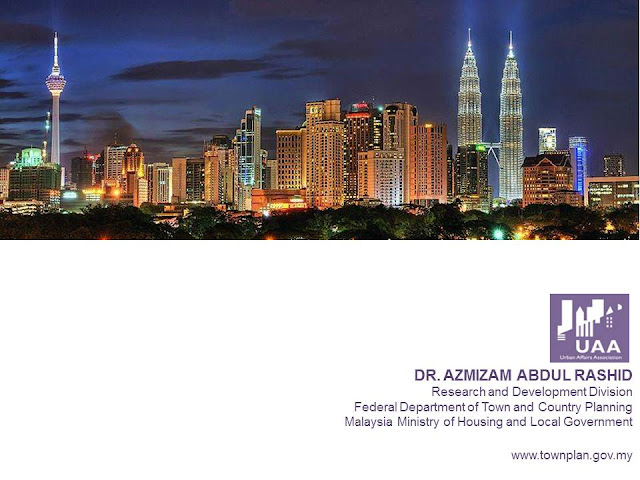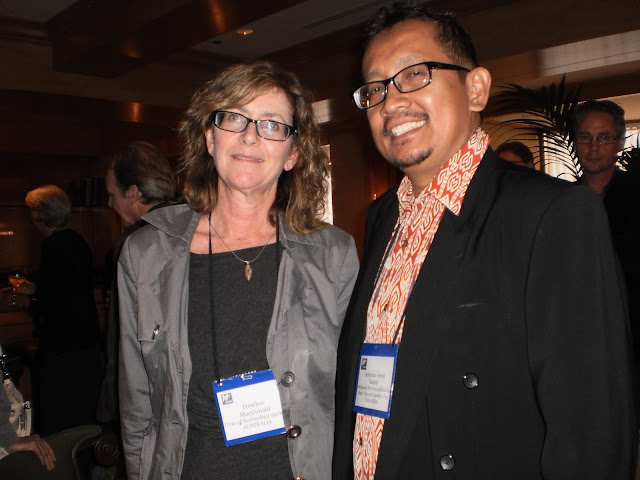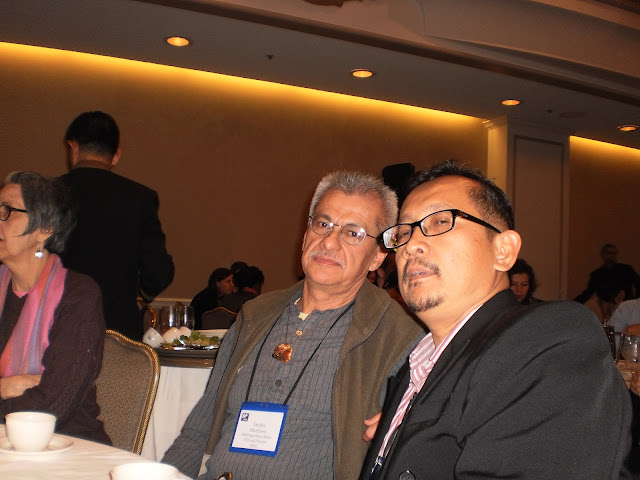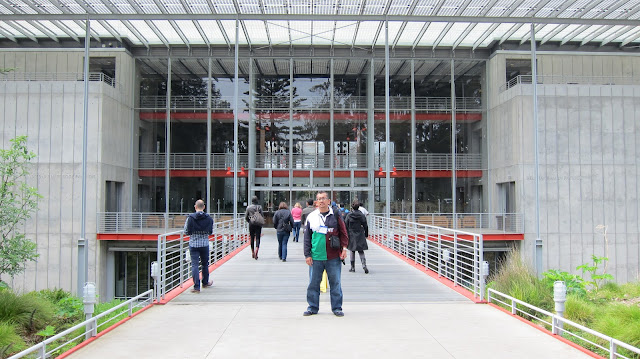Since December 2007, I created this research blog to facilitate me to do my PhD. I completed my research in December 2010 and I want to keep this blog. Its allow me to continue writing and sharing my views on urban and regional planning. This blog will create a new networking among researchers and give me a confidence but never allowed me to become complacent...DR. AZMIZAM ABDUL RASHID
Tuesday, 31 December 2013
Monday, 16 December 2013
Thursday, 18 April 2013
Sunday, 14 April 2013
Friday, 29 March 2013
43rd ANNUAL CONFERENCE OF THE URBAN AFFAIRS ASSOCIATION 3-6 APRIL2013
Federal Department of Town and Country Planning (FDTCP) Peninsular Malaysia, Ministry of Housing and Local Government will participate 43rd ANNUAL CONFERENCE OF THE URBAN AFFAIRS
ASSOCIATION :Building the 21st Century City: Inclusion, Innovation, and
Globalization will be held in San Francisco California United States of
America.. 3 papers will be presented by 3 officers from FDTCP.
MALAYSIAN
URBAN RURAL NATIONAL INDICATORS NETWORK ON SUSTAINABLE DEVELOPMENT (MURNInets)
by
Shamsaini
Shamsuddin
shamsaini.shamsuddin@townplan.gov.my
Azmizam
Abdul Rashid
Abstract
The
purpose of this article is to promote a set of criteria, indicators and indices
for sustainability assessment in major cities of Malaysia. Malaysia Urban
Indicators Network (MURNInet) is a programme developed by the Federal Department of Town and
Country Planning, Peninsular Malaysia (FDTCP) to assess the performance and
levels of sustainability of Malaysian cities. Implemented in 2002, the MURNInet
programme was a foundation for Malaysia to measure city development. MURNInet
pilot projects were launched in six Malaysian cities namely Georgetown, Johor
Bahru, Kuantan, Kuching, Pasir Mas and Batu Pahat. After almost 10 years of
implementation, in the
year 2011, MURNInet was reviewed and 6 dimensions, 21 themes and 36
indicators are introduced MURNInet is also rebranded as The Malaysian Urban
Rural National Indicators Network on Sustainable Development (MURNInets). In
search of an adequate set of indicators to develop an index, some existing
indicators and indices have been reviewed. This article focuses on the implementation of a new set of indicators to
assess urban sustainability in Malaysia. The structural change in population
and its distribution or concentration has allows for agglomeration
economies that provides greater opportunities for information and knowledge
sharing, cultural exchanges and more effective provision of services,
particularly health and education. All of these elements are essential for
social development, advancement of civil society, well-being, cultural
consolidation, change and cosmopolitanism. Function of cities as centres of
political power and administration are strengthened. The closer proximity to
the seat of power, their higher concentration and better articulation of their
demands through civil organisations have meant that urban citizens have greater
opportunities to influence policy-making and setting developmental agendas at
both local and national levels. The assessments of the sustainability of cities
are always relevant and to the selection and application of asset of sustainable
development indicators to ensure that city development are directed towards
attaining sustainable development.
Keywords
: urban sustainability, indicators,
network, measurement, local authority
REVITALIZING URBAN DEVELOPMENT IN
MALAYSIA THROUGH THE IMPLEMENTATION OF URBAN REGENERATION PROGRAMME
by
Azmizam Abdul Rashid
Abstract
Malaysia’s modern urban growth,
development and urbanisation experiences may be conveniently periodised into
three major periods, based on the form, structure and functions of the urban
centres. . In Malaysia, given the growing conditions of neglect and degradation
of the cities centers. Since most
Malaysian city centers are very old historical cities and seem to be
rediscovering now the economic value of creative industries and culture. Urban
revitalization and regeneration together with the issues of energy sustainability
and the need to reduce pollutant emissions, are today the major challenges
facing the planning of cities. The concept of urban regeneration in Malaysia’s
cities to promote a “return to the city”, revitalise the city centre, restore
activity in a fiercely competitive international context, and implement
initiatives to improve the quality of the environment operating in a wide sense
towards a smart growth. Urban
regeneration is more than just upgrading the physical environment of an area to
hopefully spark private investment. However one of most critical issue in urban
regeneration is gentrification. This should not be happening in the true spirit
of urban revitalization. Instead of displacing the existing community, they
should be relocated to the same site. Therefore urban regeneration processes
accomplishes the growing importance in literature of concepts like territorial
governance, institutional relational density, creativity, social capital, city
branding, city image and place marketing. Kuala Lumpur
City Hall is among the municipalities practices urban regeneration by
recognizing it as one of the strategic directions the city will take in an
effort to encourage more sustainable lifestyles.
Keywords : urban revitalization, urban regeneration, gentrification, public
participation
Wednesday, 20 March 2013
20 MARCH 2013 THE INTERNATIONAL DAY OF HAPPINESS: MALAYSIA’S INITIATIVE TO ENHANCE HAPPINESS OF THE PEOPLE IN THE CITY
Malaysia is committed to ensure a high quality
of life (QoL) and well-being in its urban and rural areas. The Federal Department of Town and Country Planning (FDTCP) being the focal
point for developing and coordinating the overall framework on Sustainable
Development Indicators for local authorities through MURNInets (Malaysian
Urban-Rural National Indicators Network for Sustainable
Development) has now incorporated Happiness Index into the framework. Conceived
in late 2010, the Happiness Index was based on international trends which gave
special focus on happiness in the context of the Government's effort in
improving the well-being of communities. This is in line with the Department’s
vision to be a “Leader in Town and Country Planning towards achieving a Quality
and Sustainable Living Environment by 2020”, FDTCP’s Universal Planning and
Development Doctrine produced in 1998 and the Ministry of Housing and Local
Government’s commitment in promoting Sustainable Communities.
World Happiness Report 2012 Malaysia was in a commendable 51st position
among 156 countries by virtue of our country’s economic performance where the
happiness factor was measured in terms of gross national product or gross
domestic product. Malaysia will be eyeing to chalk up its ranking in the world
and Asia Happiness Index besides aiming for higher economic growth by the year
2020. This is in line with the national transformation agenda which aims
to turn Malaysia into a high-income economy that considers happiness ranking.
Our Prime Minister is very serious in providing infrastructure and
financial aids to raise Malaysia's ranking in the happiness index under the
Economic Transformation Programme . Happiness Index has been
incorporated in MURNInets sustainable community's dimension that include
community vitality, cultural diversity and resilience, health, education,
ecological diversity, quality of life and efficiency of governance. Happiness Index Study
(HIS) in MURNInets contains findings from primary data
collection jointly administered between local authorities and residents. This
study highlights the state of happiness in the context of community and
governance. A good physical and happy environment provides the foundation for
successful sustainable communities.
In 2012, the United
Nations (UN) declared March 20 to be observed as the International Day of
Happiness. The day recognises that happiness is a fundamental human goal,
and calls upon countries to approach public policies in ways that improve the
well-being of all people. By designating a special day for happiness, the UN
aims to focus world attention on the idea that economic growth must be
inclusive, equitable, and balanced, such that it promotes sustainable
development and alleviates poverty. Additionally the UN acknowledges that in
order to attain global happiness, economic development must be accompanied by
social and environmental well-being.The initiative to declare a day of
happiness came from Bhutan – a country whose citizens are considered to be some
of the happiest people in the world. The Himalayan Kingdom has championed an
alternative measure of national and societal prosperity, called the Gross
National Happiness Index (GNH). The GNH rejects the sole use of economic and
material wealth as an indicator of development, and instead adopts a more
holistic outlook, where spiritual well-being of citizens and communities is
given as much importance as their material well-being.
A good physical
environment provides the foundation for a well-ordered city that can cater to
the material and post-material needs of its citizens—the necessary conditions,
in other words, for physical and economic vibrancy. Most people tend to associate happiness with feeling good, that is, with
a life that offers a variety of pleasure and comfort. Happiness index of
the people is a framework for decision-making and policy development. It
provides guidance to local authorities interested in improving the level of
well-being of its communities. The challenge for us now is to overcome our constraints and
expand the mental and cultural space that we have. So anyone who wishes to
keep themselves engaged and energetic in their work and their community, could
contribute better towards creating a livable and vibrant city.
Subscribe to:
Comments (Atom)
PEOPLE AROUND ME..FAMILY AND FRIENDS.

To my Wife, Zulaini, my sons Zulazlan, Zulazman, Zulazmir, Zulazmin dan my daughter, Nuris Zulazlin...I love you all..thank you being with me
CIRCLE OF FRIENDS... KUALA LUMPUR PROJECT OFFICE

Thank you guys...for your support and encouragement
2007 / 2008 METHODOLOGY AND QUALITATIVE RESEARCH COURSE FOR PHD CANDIDATES

My new friends during my course in INTAN 9 Jan -2 Mac 2007
KUALA LUMPUR PROJECT OFFICE, JOURNEY TO MOUNT OF KINABALU SABAH 21-22 JANUARY 2006

WE CAME, WE SAW, WE CONQUERED 4095.2 METER ABOVE SEA LEVEL

How are you, guys? Where you are now?



























.JPG)






